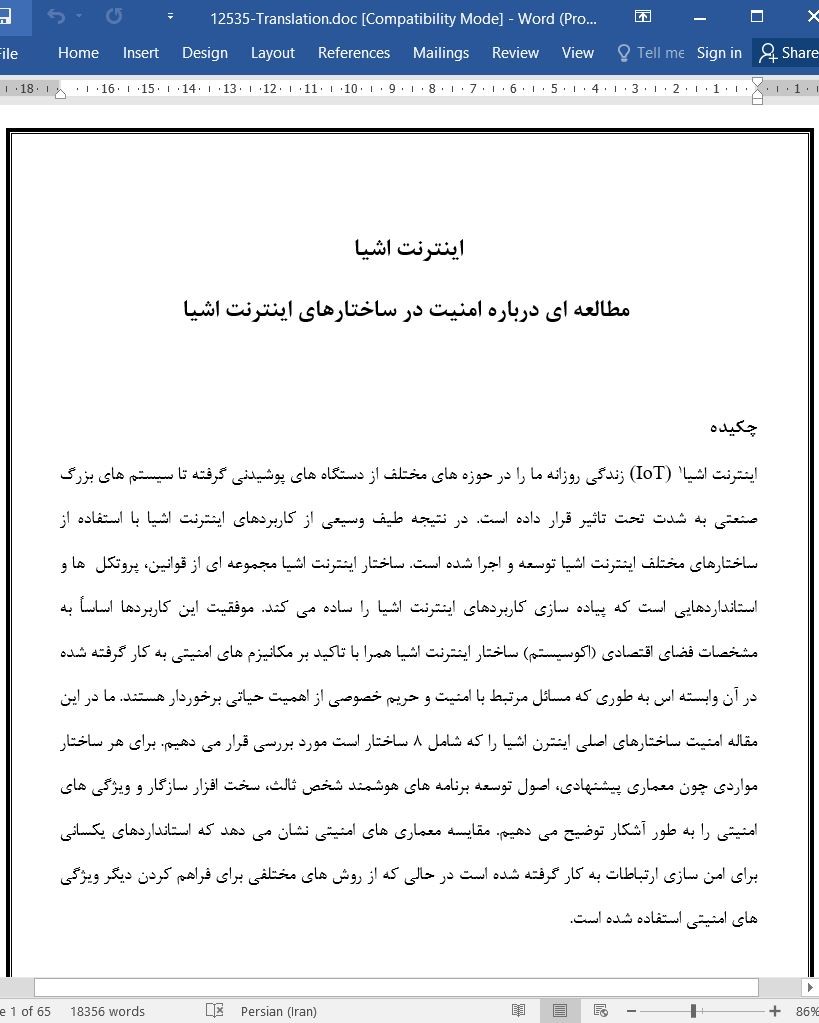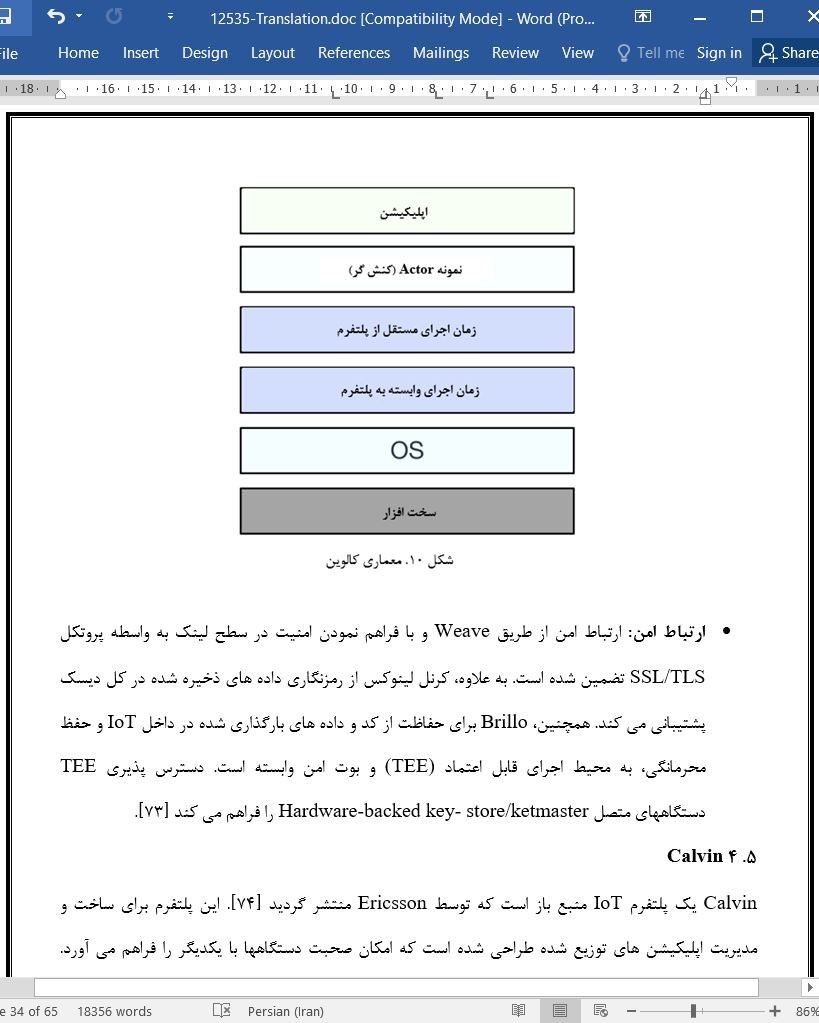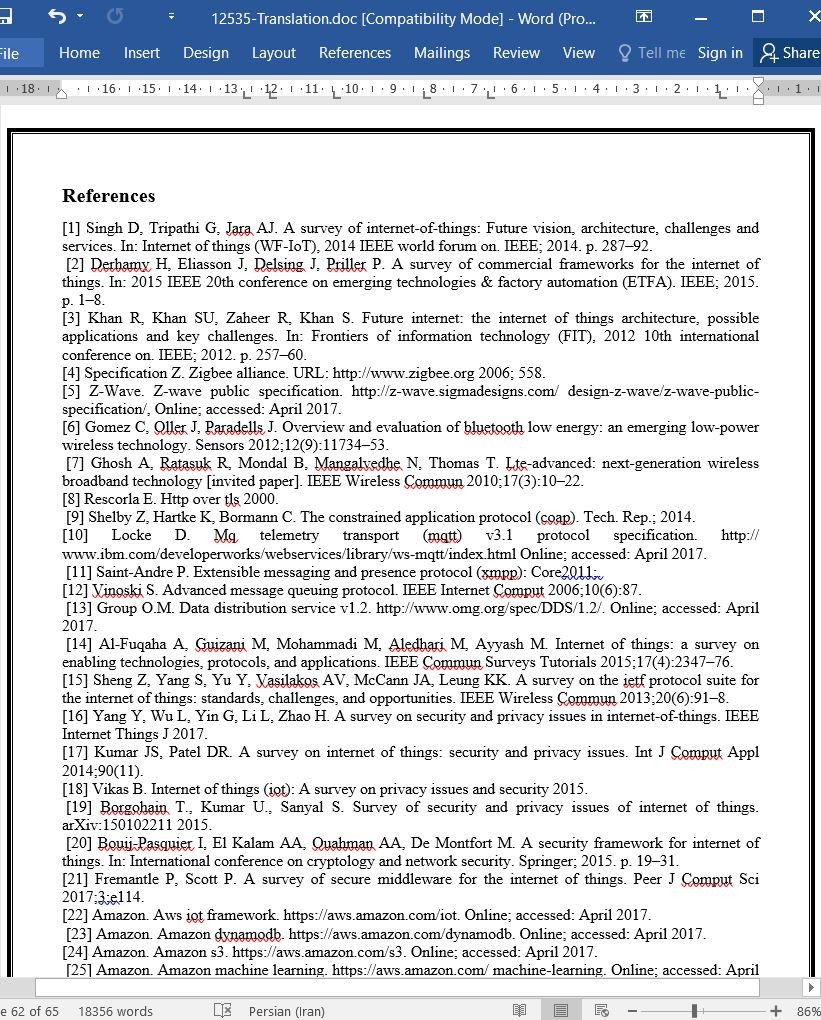
دانلود مقاله اینترنت اشیا: مطالعه ای درباره امنیت در ساختارهای اینترنت اشیا
چکیده
اینترنت اشیا (IoT) زندگی روزانه ما را در حوزه های مختلف از دستگاه های پوشیدنی گرفته تا سیستم های بزرگ صنعتی به شدت تحت تاثیر قرار داده است. در نتیجه طیف وسیعی از کاربردهای اینترنت اشیا با استفاده از ساختارهای مختلف اینترنت اشیا توسعه و اجرا شده است. ساختار اینترنت اشیا مجموعه ای از قوانین، پروتکل ها و استانداردهایی است که پیاده سازی کاربردهای اینترنت اشیا را ساده می کند. موفقیت این کاربردها اساساً به مشخصات فضای اقتصادی (اکوسیستم) ساختار اینترنت اشیا همرا با تاکید بر مکانیزم های امنیتی به کار گرفته شده در آن وابسته اس به طوری که مسائل مرتبط با امنیت و حریم خصوصی از اهمیت حیاتی برخوردار هستند. ما در این مقاله امنیت ساختارهای اصلی اینترن اشیا را که شامل 8 ساختار است مورد بررسی قرار می دهیم. برای هر ساختار مواردی چون معماری پیشنهادی، اصول توسعه برنامه های هوشمند شخص ثالث، سخت افزار سازگار و ویژگی های امنیتی را به طور آشکار توضیح می دهیم. مقایسه معماری های امنیتی نشان می دهد که استانداردهای یکسانی برای امن سازی ارتباطات به کار گرفته شده است در حالی که از روش های مختلفی برای فراهم کردن دیگر ویژگی های امنیتی استفاده شده است.
1. مقدمه
اینترنت اشیا نقش قابل توجه در تمامی جنبه های زندگی روزمره ما ایفا می کند. این فناوری بسیاری از حوزه ها از جمله بهداشت و دمان، خودروها، سرگرمی ها، تجهیزات صنعتی، ورزش، منازل و غیره را پوشش می دهد. فراگیر بودن اینترنت شیا برخی از فعالیت های روزانه را ساده می کند، روش تعامل افراد با محیط زیست و اطراف را بهبود می بخشد و تعاملات اجتماعی ما را با افراد و اشیای دیگر تقویت می کند. با این حال، این نگاه کلی نگرانی هایی را نیز ایجاد می کند: اینترنت اشیا چه سطحی از امنیت را می تواند فراهم کند و چگونه آن را ارائه می کند و به چه صورت از حریم خصوصی کاربران خود محافظت می کند؟
توسعه برنامه ها برای اینترنت اشیا به این دلایل می تواند فعالیت چالش برانگیزی باشد: (1) پیچیدگی زیاد رایانش (محاسبات) توزیع شده، (2) کمبود دستورالعمل های کلی یا ساختارهایی که ارتباطات سطح پایین را مدیریت نماید و پیاده سازی سطح بالا را ساده کند، (3) زبان های برنامه نویسی متعدد و (4) پروتکل های مختلف ارتباطی. همچنین دربرگیرنده توسعه دهندگان برای مدیریت زیرساخت و مدیریت هر دو لایه سخت افزار و نرم افزار همراستا با حفظ تمامی الزامات کاربردی و غیر کاربری نرم افزار است. این پیچیدگی منجر به تکامل سریع براساس معریف چارچوب های برنامه نویسی اینترنت اشیا شده است که چالش های اشاره شده فوق را مدیریت می کند.
اخیراً ساختارهای متعدد اینترنت اشیا توسط ذینفعان مهم در حوزه اینترنت اشیا و محققان به منظور پشتیبانی و ساده سازی توسعه، اجرا و نگهداری کاربردهای اینترنت اشیا پیاده سازی شده است. هر نقش آفرین روش مخصوص به خود را بر اساس نگاه خود نسبت به دنیای اینترنت اشیا ایجاد کرده است [1]. ما در این پژوهش ویژگی های زیرمجموعه ای از چارچوب های اینترنت اشیا را به ویژه با هدف قرار دادن ویژگی های امنیتی آن ها مورد مقایسه قرار می دهیم. این زیرمجموعه منتخب از پلتفورم های اینترنت اشیا شامل این موارد است: AWS IoT مربوط به شرکت Amazon، ARM Bed مربوط به شرکت ARM و همکاران دیگر، Azure IoT Suite مربوط به شرکت مایکروسافت، Brillo/Weave مربوط به شرکت گوگل، Calvin از شرکت Ericsson، HomeKit از شرکت Apple، Kura از شرکت Eclipse و SmartThings از شرکت Samsung.
6. نتیجه گیری
بازار IoT به سرعت در حال رشد است و در نتیجه توجه از تک عناصر و پروتکل های IoT به سمت پلتفرم های کاربردی معطوف شده است تا به این ترتیب چارچوب هایی که از مجموعه های IoT استاندارد از مقررات و پروتکل ها پشتیبانی می کنند، شناسایی شوند. این مطالعه زیرمجموعه ای از چارچوب هاو پلتفرم های تجاری موجود برای توسعه اپلیکیشن های IoT مبتنی بر مصرف کننده و صنعتی را پوشش داده است. چارچوب های منتخب از لحاظ شناسایی اپلیکیشن های مبتنی بر ابر دارای فلسفه طراحی یکسانی بوده و بر منابع داده توزیع شده تمرکز می کنند. اما برای استفاده از این فلسفه، شیوه های مختلفی را دنبال کردند. تحلیل مقایسه ای چارچوب ها براساس معماری، سازگاری سخت افزاری، نیازمندیهای نرم افزاری و امنیت، انجام شد. در این مقاله توضیح دادیم که معیارهای امنیتی هر چارچوب که ویژگیهای امنیتی و ایمنی در برابر حملات را تصدیق می کنند، یکی از مهمترین موضوعات معاصر می باشند که اینترنت اشیاء با آن مواجه است.
Abstract
The Internet of Things (IoT) is heavily affecting our daily lives in many domains, ranging from tiny wearable devices to large industrial systems. Consequently, a wide variety of IoT applications have been developed and deployed using different IoT frameworks. An IoT framework is a set of guiding rules, protocols, and standards which simplify the implementation of IoT applications. The success of these applications mainly depends on the ecosystem characteristics of the IoT framework, with the emphasis on the security mechanisms employed in it, where issues related to security and privacy are pivotal. In this paper, we survey the security of the main IoT frameworks, a total of 8 frameworks are considered. For each framework, we clarify the proposed architecture, the essentials of developing third-party smart apps, the compatible hardware, and the security features. Comparing security architectures shows that the same standards used for securing communications, whereas different methodologies followed for providing other security properties.
1. Introduction
The Internet of Things (IoT) plays a remarkable role in all aspects of our daily lives. It covers many fields including healthcare, automobiles, entertainments, industrial appliances, sports, homes, etc. The pervasiveness of IoT eases some everyday activities, enriches the way people interact with the environment and surroundings, and augments our social interactions with other people and objects. This holistic vision, however, raises also some concerns, like which level of security the IoT could provide? and how it offers and protects the privacy of its users?
Developing applications for the IoT could be a challenging task due to several reasons; (i) the high complexity of distributed computing, (ii) the lack of general guidelines or frameworks that handle low level communication and simplify high level implementation, (iii) multiple programming languages, and (iv) various communication protocols. It involves developers to manage the infrastructure and handle both software and hardware layers along with preserving all functional and non-functional software requirements. This complexity has led to a quick evolution in terms of introducing IoT programming frameworks that handle the aforementioned challenges.
Very recently, several IoT frameworks have been launched by the major shareholders in the IoT domain and by the research community in order to support and make it easy to develop, deploy and maintain IoT applications. Each player built his approach depending on his vision towards the IoT world [1]. In this survey, we compare the properties of a subset of IoT frameworks, targeting in particular their security features. The selected set of IoT platforms1 includes: AWS IoT from Amazon, ARM Bed from ARM and other partners, Azure IoT Suite from Microsoft, Brillo/Weave from Google, Calvin from Ericsson, HomeKit from Apple, Kura from Eclipse, and SmartThings from Samsung.
6. Conclusion
The IoT market is growing rapidly and as a consequence the attention has shifted from proposing single IoT elements and protocols towards application platforms in order to identify frameworks supporting the standard IoT suites of regulations and protocols. This study has covered a subset of commercially available frameworks and platforms for developing industrial and consumer based IoT applications. The selected frameworks have the same design philosophy in terms of identifying cloud-based applications by centralizing distributed data sources. However, they followed various approaches in order to apply this philosophy. A comparative analysis of the frameworks was conducted based on the architecture, hardware compatibility, software requirements, and security. We highlighted on the security measures of each framework as verifying the various security features and immunity against attacks is one of the most important contemporary issues facing the Internet of Things.
چکیده
1. مقدمه
2. پیشینه
3. کارهای مرتبط
4. ساختارهای اینترنت اشیا
4-1 AWS IoT
4-1-1 معماری
4-1-2 مشخصات برنامه های هوشمند
4-1-3 مشخصات سخت افزاری
4-1-4 ویژگی های امنیتی
2. 4 ARM mbed IOT
1. 2. 4 معماری
2. 2. 4 خصوصیات اپلیکیشن های هوشمند
3. 2. 4 خصوصیات سخت افزاری
4. 2. 4 ویژگیهای امنیتی
3. 4 Azure IoT Suite
1. 3. 4 معماری
2. 3. 4 خصوصیات اپلیکیشن هوشمند (اسمارت)
3. 3. 4 خصوصیات سخت افزاری
4. 3. 4 ویژگیهای امنیتی
4. 4 Brillo/Weave
1. 4. 4 معماری
2. 4. 4 خصوصیات اپلیکیشن های هوشمند
3. 4. 4 خصوصیات سخت افزاری
4. 4. 4 ویژگیهای امنیتی
5. 4 Calvin
1. 5. 4 معماری
2. 5. 4 خصوصیات اپلیکیشن های هوشمند
3. 5. 4 خصوصیات سخت افزاری
4. 5. 4 ویژگیهای امنیتی
6. 4. HomeKit
1. 6. 4 معماری
2. 6. 4 خصوصیات اپلیکیشن هوشمند
3. 6. 4 خصوصیات سخت افزاری
4. 6. 4 ویژگیهای امنیتی
7. 4. Kura
1. 7. 4. معماری
2. 7. 4 خصوصیات اپلیکیشن های هوشمند
3. 7. 4 خصوصیات سخت افزاری
4. 7. 4 ویژگیهای امنیتی
8. 4. SmartThings
1. 8. 4 معماری
2. 8. 4 خصوصیات اپلیکیشن های هوشمند
3. 8. 4 خصوصیات سخت افزاری
4. 8. 4 ویژگیهای امنیتی
5. بحث
6. نتیجه گیری
منابع
ABSTRACT
1. Introduction
2. Background
3. Related work
4. IoT Frameworks
4.1. AWS IoT
4.1.1. Architecture
4.1.2. Smart applications specifications
4.1.3. Hardware specifications
4.1.4. Security features
4.2. ARM mbed IoT
4.2.1. Architecture
4.2.2. Smart applications specifications
4.2.3. Hardware specifications
4.2.4. Security features
4.3. Azure IoT Suite
4.3.1. Architecture
4.3.2. Smart application specifications
4.3.3. Hardware specifications
4.3.4. Security features
4.4. Brillo/Weave
4.4.1. Architecture
4.4.2. Smart applications specifications
4.4.3. Hardware specifications
4.4.4. Security features
4.5. Calvin
4.5.1. Architecture
4.5.1. Architecture
4.5.3. Hardware specifications
4.5.4. Security features
4.6. HomeKit
4.6.1. Architecture
4.6.2. Smart application specifications
4.6.3. Hardware specifications
4.6.4. Security features
4.7. Kura
4.7.1. Architecture
4.7.2. Smart applications specifications
4.7.3. Hardware specifications
4.7.4. Security features
4.8. SmartThings
4.8.1. Architecture
4.8.2. Smart applications specifications
4.8.3. Hardware specification
4.8.4. Security features
5. Discussion
6. Conclusion
References
- اصل مقاله انگلیسی با فرمت ورد (word) با قابلیت ویرایش
- ترجمه فارسی مقاله با فرمت ورد (word) با قابلیت ویرایش، بدون آرم سایت ای ترجمه
- ترجمه فارسی مقاله با فرمت pdf، بدون آرم سایت ای ترجمه



